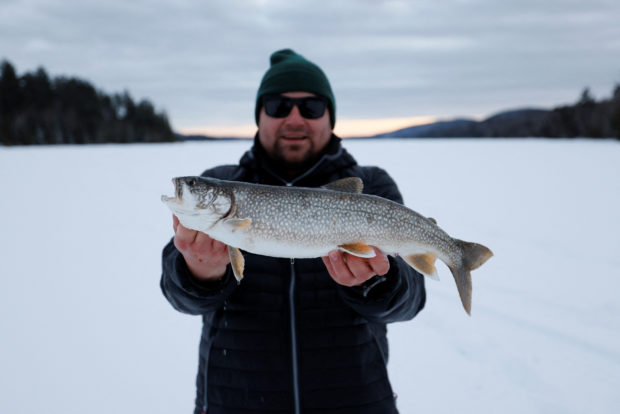
Indigenous fisherman Mike Diabo holds the wild lake trout he pulled through the ice on a lake in the Kitigan Zibi Anishinabeg Reserve, Quebec, Canada, February 8, 2023. First Nations ice fishermen risk going out on ice as climate change affects the quality of the ice. REUTERS
KITIGAN ZIBI, Canada — Most winters, at least once a week, Mike Diabo will snowmobile to the shores of one of his local lakes in southern Quebec, carry his fishing gear across the frozen surface, and drill down through the ice to reveal the dark water beneath.
There he’ll fish for northern pike, bass, trout, and whitefish to supplement his family’s diet, continuing the traditions of his Anishinabe ancestors, part of the Algonquin First Nation of eastern Canada.
But this year ice-fishing season started late, delayed by a warm winter and fluctuating temperatures that left the ice on Bitobi and Cedar Lakes – his two favourite haunts – slushy and dangerously thin until a cold snap finally arrived in early February.
This winter is on track to be among the five warmest in southern Quebec since records began in 1938, according to the Weather Network. In Canada’s capital Ottawa, just over an hour south of the Kitigan Zibi reserve where Diabo and his family live, it’s the first in which the Rideau Canal Skateway has been unable to open for ice skating.
Diabo, 46, has only been out fishing four times so far this winter. Usually he would start no later than early January. He blames climate change for the unseasonal weather and worries ice fishing season will only get shorter in future.
The thin ice has deprived his family of an important part of their diet and a practice that roots them to their cultural heritage and homeland. The limited fishing opportunities also underscore the risk climate change presents to many Canadian First Nations that rely on hunting, fishing and foraging to help boost their nutrition and combat food insecurity.
“We’re not getting the consistent number of days that are well below zero for the lake to freeze over,” said Diabo, who is on paternity leave from his high school teaching job.
“We should have got what we have now more than a month ago. Being able to get out there and safely fish and travel around on the water systems and hunt, it’s all been pushed back.”
In Ottawa the mean temperature in January was -5.9 Celsius (21.4 Fahrenheit), according to the Weather Network, well above the -10.3C average. Temperatures this year are being driven by the La Niña weather phenomenon, while climate change has made mild winters more likely than they were a few decades ago, said Doug Gillham, manager of the Weather Network’s forecast centre.
Land literacy
Food insecurity among Indigenous people living on reserves is four times the Canadian average, according to a First Nations Food, Nutrition and Environment Study published in 2021.
Although traditional food makes up only a small part of Indigenous people’s diet, it tends to be their main source of key nutrients like iron and zinc, said Malek Batal, a nutrition professor at the Université de Montréal.
“People tell us across the board they would like more traditional food but there are barriers, and one of them is climate change,” Batal said. “The animals are not behaving the way they used to, the seasons are shorter, there’s a decline in the number of animals and fish.”
Local moose herds, another important food source for the Algonquin, are already in decline due to logging and mining activities.
Families in communities like Kitigan Zibi wind up spending more in grocery stores to supplement their diet.
Diabo, a father of five, said the fluctuating temperatures and occasional days of rain were making the ice less safe. Rabbit-trapping with his two middle children has been put on hold because of less snow than usual.
Late, mild winters shorten the window of time for his children to develop the “land literacy” that Indigenous people have handed down through generations: knowing how to read the ice and tracks in the snow, how to set snares, and understand how different species react to seasonal weather patterns.
“The opportunities to be transmitting things like legacy and tradition and really important land-based skills that are key to our identity are missed,” he said.